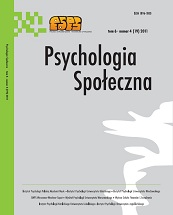Samoregulacja i samokontrola powinnościowe: analiza psychometryczna Skali Rozbieżności Ja (SkRAP)
Self-regulation, self-control, and the ought self. Measuring ought self-discrepancy: A psychometric analysis of SkRAP
Author(s): Kamila WojdyłoSubject(s): Psychology
Published by: Wydawnictwo Naukowe Scholar Sp. z o.o.
Keywords: self-discrepancy; ought self; self-regulation; self-control
Summary/Abstract: This paper presents research on self-discrepancy in the context of two distinct regulatory processes: selfregulation and self-control (Kuhl, 2001; Deci & Ryan, 2008). According to the Self-Discrepancy Theory (Higgins, 1987) the ought self plays a crucial role in behavior regulation, and is considered the main mechanism of moral actions. We performed the confirmatory factor analysis to test the four-factorial structure of the Polish Self-Discrepancy Questionnaire (SkRAP). We predicted that both the actual self and the ought self consist of two types of traits. The first type is associated with high self-control processes that are mostly externally driven (e.g., persistence, hard work, and strong will), and the second one represent selfregulatory processes, definedas an autonomous control over one’s actions (e.g., intelligence, creativity, and wisdom). Analysis confirmed the model (RMSEA =.08, CFI =.94). Additional analyses confirmed the convergent validity of SkRAP. For example, it was revealed that the actual vs. ought self-discrepancy correlated positively with negative affect, prevention, and assessment of self-competence. On the other hand, results showed that the actual vs. ought self-discrepancy was negatively related to the positive affect, life- satisfaction, and orientation on agency. The questionnaire can be applied in different areas of psychological interventions, for example in the diagnosis of various disorders (anorexia nervosa or workaholism) or in stimulation of self-growth, i.e. creativity development.
Journal: Psychologia Społeczna
- Issue Year: VI/2011
- Issue No: 19
- Page Range: 375-390
- Page Count: 15
- Language: Polish

